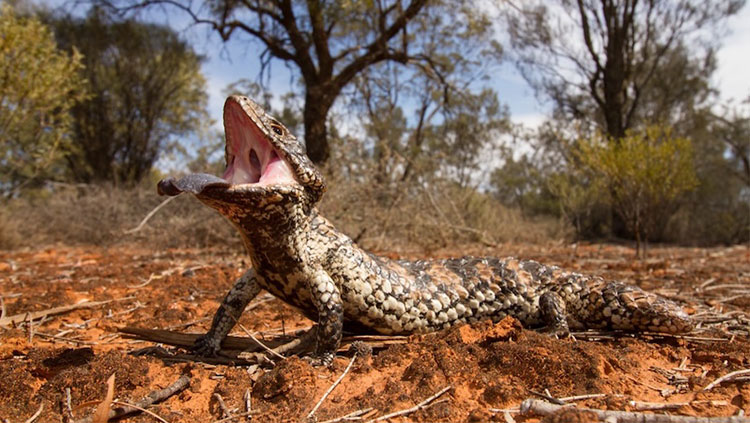Smoke signals danger for sleepy lizards
Australia's 'sleepy lizards' can smell approaching bushfires and flee to safety, but ignore the sound of flames.

Balaclava Rd, North Ryde, Macquarie University
NSW 2109 Australia
How do they sleep while their beds are burning? Sleepy lizards wake to flee from fire
Australian researchers have discovered that sleepy lizards (Tiliqua rugosus) can recognise the smell of smoke as a sign of approaching fire and attempt to escape; but the sound of fire doesn’t trigger any response.
The study, published this month in Biology Letters, provides the first empirical test of an amusing anecdote: when zookeepers at a US zoo burnt their lunch, they noticed they were not alone in smelling the acrid smoke.
Captive sleepy lizards became agitated by the smell wafting through the building, while other reptiles remained calm. Despite being mostly captive-bred, the lizard’s tongue-flicked, paced, and tried to escape – behaviour researchers now show appears innate, not learned.
“Many animals from fire-prone regions, such as Australia, appear to have this miraculous ability to survive their homes being burnt,” says lead author Dr Chris Jolly, an evolutionary biologist from Macquarie University.
“Our study demonstrates that some lizards innately recognise smoke as a cue of approaching fire and respond by running away.”
Why it matters
As wildfires intensify under climate change, understanding how animals survive fires is critical. While people often assume wildlife caught in fires have little chance of survival, research is revealing that many species have evolved strategies to detect and escape fire.
This study suggests that fire-prone environments have shaped the sensory systems and behaviours of animals such as sleepy lizards, enabling them to respond to smoke as an early-warning signal.
“As fires become more frequent, intense and unpredictable – including in habitats that rarely burned in the past, like rainforests – we need to know which species can respond to fire cues, and which are most vulnerable,” Dr Jolly said.
Evolutionary insights
The researchers exposed wild-caught sleepy lizards to both the smell of smoke and the sound of crackling fire. The results were clear: lizards spent much more time moving and travelled much greater distances when exposed to smoke compared to odourless water vapour. However, they showed no special response to fire sounds.
Sleepy lizards – also known as shinglebacks or bobtails – are large, slow-moving skinks found across southern Australia. They live in regions where bushfires naturally occur every 20-100 years, creating strong evolutionary pressure to develop fire-detection abilities.
The lizards used in the research were captured from an area that hasn’t burned in over 50 years, and – like the captive-born zoo lizards that first inspired this research – likely had no previous fire experience.
In the open landscapes where sleepy lizards live, smoke can travel long distances, providing an early warning system. In contrast, the sound of fire may be less reliable, especially for reptiles with limited hearing compared to mammals and birds.
The study suggests recognising smoke as a danger signal is an innate behaviour – something these lizards are born knowing how to do.
The findings support the idea that Australia’s fire-prone environments have shaped the sensory systems and behaviours of native animals over evolutionary time.
Climate Change Connection
The research takes on new urgency as climate change makes wildfires more frequent and severe worldwide.
Understanding how animals detect and respond to fire could be crucial for predicting which species are most vulnerable to changing fire patterns.
“As fires become more frequent, intense and unpredictable – including in habitats that rarely burned in the past, like rainforests – we need to know which species can respond to fire cues, and which are most vulnerable,” says Dr Jolly.
From Australian possums and bats that wake from deep sleep when they smell smoke, to Mediterranean lizards that show stronger responses to fire cues than their counterparts from less fire-prone areas, a picture is emerging of sophisticated fire-detection abilities across many species.
The researchers say more work is needed to understand how different species and populations respond to fire cues. Comparing closely related species from areas with different fire histories could help scientists better understand whether these behaviours represent evolutionary adaptations or more general threat responses.
FULL RESEARCH TEAM: Dr Chris J. Jolly (Macquarie University and Charles Darwin University), Prof Dale G. Nimmo (Charles Sturt University), Dr Alexandra J. R. Carthey (Macquarie University), Ms Emma H. V. van de Pas (Van Hall Larenstein University of Applied Sciences, The Netherlands), and Professor Martin J. Whiting (Macquarie University).